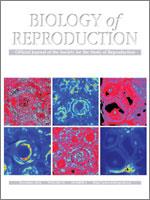Phospholipid metabolism and signaling influences on early pregnancy events in cattle are unknown. This study aimed to characterize global phospholipid composition of oviduct and uterus during early diestrus in a model of contrasting embryo receptivity. Beef cows were treated to ovulate a larger (LF-LCL group, associated with greater receptivity) or smaller (SF-SCL group) follicle and, consequently, to present greater or smaller plasma concentrations of estradiol during proestrus-estrus, as well as progesterone during early diestrus. Oviduct and uterus (4 days after gonadotropin-releasing hormone-induced ovulation; D4) as well as the uterus (D7) were collected, and lipid profiles were monitored by matrix-assisted laser desorption/ionization mass spectrometry (MALDI-MS). This technique allowed the identification and tissue localization of sphingomyelins (SM), phosphatidylcholines (PC), ceramides (Cer), and phosphatidylethanolamines (PE). Multivariate statistics were used to separate samples into groups with distinctly different phospholipid profiles in the uterus at D4 and D7. Different abundance of ions corresponding to specific lipids were detected on D4 (Cer [42:1], PC [31:0], PC [32:1], PC [34:4], and PC [36:4] greater for LF-LCL group; and PC [38:7], PC [38:5], PC [38:4], PC [40:7], and PC [40:6] greater for SF-SCL group) and D7 (SM [34:2], SM [34:1], PC [32:1], and PC [35:2] greater for LF-LCL group). The MALDI-MS imaging showed the spatial distributions of major phospholipids. In conclusion, distinct phospholipid profiles were associated with animals treated to show contrasting receptivity to the embryo. Functional roles of the identified phospholipids on uterine function and preimplantation embryo development deserve further studies.
How to translate text using browser tools
19 October 2016
Phospholipid Profile and Distribution in the Receptive Oviduct and Uterus During Early Diestrus in Cattle
Katia Roberta A. Belaz,
Alessandra Tata,
Moana R. França,
Maressa I. Santos da Silva,
Pedro Henrique Vendramini,
Anna Maria A.P. Fernandes,
Fábio L. D'Alexandri,
Marcos N. Eberlin,
Mario Binelli
ACCESS THE FULL ARTICLE

Biology of Reproduction
Vol. 95 • No. 6
December 2016
Vol. 95 • No. 6
December 2016
lipidomics
MALDI-MS
mass spectrometry
oviduct
sex steroids
uterus




